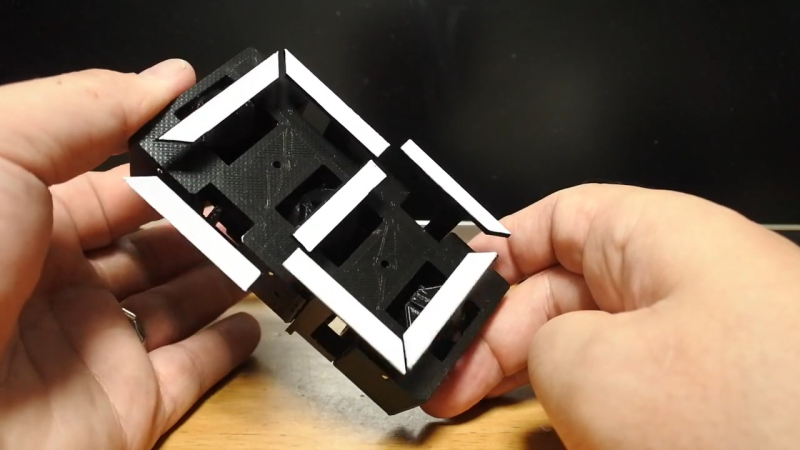The seven-segment display may be a bit prosaic after all these years, but that doesn’t mean there aren’t ways to spice it up. Coming up with a mechanical version of the typical photon-based display is a popular project, of which we’ve seen plenty of examples over the years. But this seven-segment display is quite a mechanical treat, and a unique way to flip through the digits.
With most mechanical displays, we’re used to seeing the state of each segment changed with some kind of actuator, like a solenoid or servo. [Shinsaku Hiura] decided on a sleeker design using a 3D-printed barrel carrying one cam for each segment. Each hinged segment is attached to an arm that acts as a follower, riding on its cam and flipping on or off in a set pattern. Which digit is displayed depends on the position of the barrel, which is controlled with a single servo and a pair of gears. It trades mechanical complexity for electrical simplicity and overall elegance, and as you can see from the video below, it’s pretty snappy.
We think the best part of this build is figuring out the shape of the cams. We wonder how they compare to the cam profiles in [Greg Zumwalt]’s mechanical display; it uses two separate discs with grooves, but the principle is pretty much the same.
Thanks to [Jan Derogee] for the tip.
















This is a furby-esque design. It would only be closer by linking multiple digits to flip through the time using a cheap-o geared motor and a current sensor to detect when a digit flipped.
I have already made a mechanical 4-digit clock with former design of mechanical segment decoder,
https://www.thingiverse.com/thing:4626956
In the near feature I will make new clock with this improved design.
Very clever! Nice work!
The clock is great
oh, it’s nice but …
Can he please make one for hexadecimal ? :-D
Obviously, that’s just a matter of making a different, 16-position cam. Or you could do it, modifying the file for that cam on Thingiverse. It’s what we like to call “hacking”.
Thank you for your comment, that is right, and actually it will be a bit difficult to increase the number of cam position because of the cam profile problem. My another design of mechanical clock
https://youtu.be/Iom0Bg0sHtQ
https://www.thingiverse.com/thing:4939540
has an ability to show hexadecimal because all 7 segments can be turned on or off independently.
Well. Hexadecimal can be displayed with 7-segments. You meant 16-segments display, i guess.
Unless I’m mistaken .. I dont think this can independently trigger each segment. It can only step through the decimal numbers, right?
Yes, it can show only 0-9. My another design
https://youtu.be/Iom0Bg0sHtQ
can theoretically show any combination of 7 segments, including hexadecimal.
There is a separate cam for each segment. The cams are split into 10 sectors, each of which encodes one numeral. If you want to display one of sixteen numerals, you just need to make a cam that is split into 16 sectors. Sure, it needs a change to the hardware, but that cam is essentially the encoder ROM, so it’s really just the same hardware with different firmware.
If you really wanted to have independent control of each segment, that would be a waste of this design – you just need a mechanical linkage to each segment. Of course, you COULD encode it with 128 sectors which WOULD give you independent segment control, but a) that would be a lot more difficult to make work (only about 2.8 degrees of arc on each cam for each code), and b) it would be pointless, unless your main objective is to just have one electrical component in the display.
It is possible to get a form of alphabet A-Z on a plain 7-segment display. It was invented by Wayne Green, editor of Kilobaud magazine and a small article published about it therein during the late 70s early 80s.
Unfortunately I can’t recall the issue but they are all up on archive.org if someone has the time and inclination to search them.
Here’s a later version someone’s done https://margaretshepherd.blogspot.com/2013/05/114-7-segment-display.html
Which is fine, as long as a) you don’t mind that some of the characters don’t look much like the letters they represent, and b) you don’t also want to display numerals. Seems pretty pointless, really, and it’s the reason 14-segment displays were invented. Which also nobody was ever happy with, since it just shifted the problem to how to represent the 6-bit subset of ASCII that Teletype 33s could display and OSs of the time expected.
That’s clever!
This is by far the simplest mechanical 7-segment display I’ve seen. The double-acting cam followers don’t need any springs, and couple directly to the segments without any additional moving parts. Bravo!
Just another idea for the mechanism behind the display.
Have a single motor with a disk and a pin on it. When the motor turns clockwise it resets the segments one at the time, and when the motor runs counterclockwise it sets a segment.
This way all segments can be manipulated individually.
I think that the “Chumby” used to used a similar mechanism to actuate various functions with a single motor.
Using combinations of CW / CCW rotation, we can control 7 segments individually with 4 rotors. Please take a look at my another design,
https://www.thingiverse.com/thing:4939540
any instructions on how to build it?
Please visit to
https://www.thingiverse.com/thing:5066794
I published some parametric G-code to machine cams for this exact purpose:
https://bodgesoc.blogspot.com/2016/11/cams.html
Piece of art, is the dwg file somewhere to find?(not as stl file)